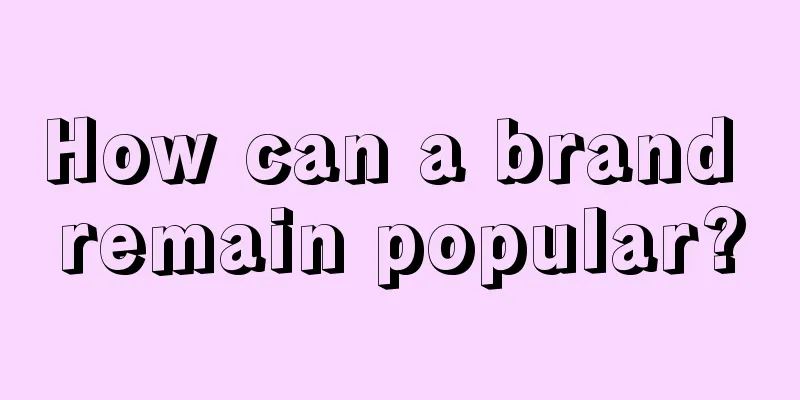How can a brand remain popular?

I have been thinking recently, how can I continue to be popular? I have observed the curves of different things becoming popular, which can be roughly divided into five categories: The first category is the cliff-like popularity. A typical example is Perfect Diary. Its popularity was like a flash in the pan, it quickly became popular and then quickly declined. The second type of popularity curve is like a long snow slope. The popularity of Andy Lau, Jackie Chan, Tony Leung, Coca-Cola and Nike are all of this type. They discovered "very wet snow" and "very long slopes". Once they become popular, their resources and energy will continue to accumulate like a snowball, and then they will stay at the top of the industry and lead the trend of the industry. The third type of popularity is step-by-step, like Microsoft and Li Ning, which rise in fits and starts. They have experienced career lows, but they also have the ability to create a second curve. For example, Li Ning, which once fell into "brand aging", returned to the peak by relying on the "national tide". The fourth popularity curve is a steep rise. The actors Zhang Songwen, Zhou Yiwei, and Lei Jiayin, and the brand Lao Gan Ma, give people the feeling that they became famous overnight. They have been unknown for many years, working in their own fields, and then at a certain moment they burst out with great success and continue to be popular. The last type of popularity curve is like your heartbeat, which is stable and lukewarm most of the time. It will only become red occasionally when it is stimulated by some special stimuli. For example, when "The Lost Tomb of Dragon Ridge" was released, Pan Yueming, who had been silent for many years, became popular for a while, but soon returned to calm. Northeast Daban was once popular several times for its nostalgic style and cheap large bowls, but now it has become unpopular. Although I have classified various types of popularity, I discovered a sad fact during my research: there may be many reasons for unpopularity, but long-lasting brands have similar commonalities. As Tolstoy said: "All happy families are alike; each unhappy family is unhappy in its own way." For example, Shi Hang became famous because of his quarrel with Guo Jingming's fans. He was only the sixth screenwriter of "Iron Teeth and Bronze Teeth Ji Xiaolan", but became a popular screenwriter by relying on his ability to mix in the circle and gain traffic. Recently, he became unpopular because of a sexual harassment incident. For example, Zhang used technical methods to show the life of the "rough guys" in Northeast China, and gained 18 million followers in two months. However, because of the repetitive content day after day, it could not satisfy the users' picky taste buds and soon returned to normal. So, what is the difference between "becoming popular" and "staying popular"? I would like to explain this with the logic of marketing. I think: All brands that can continue to be popular have a firm grasp of customers' "consumption motivations", while brands that are only popular for a while will sooner or later deviate from customers' consumption motivations. In the past two years, two places in Shandong, China have become popular, one is called Zibo and the other is called Cao County. The little-known Cao County came into the public eye because a local internet celebrity shouted the slogan "Cao County, Heze, Shandong 666, I would rather have a bed in Cao County than an apartment in Pudong" during a live broadcast, which attracted many internet celebrities to imitate it in an exaggerated manner. As more and more people pay attention to Cao County, its coffin and Hanfu industries have been dug up. The reason why Zibo became so popular is that during the epidemic lockdown, a group of college students made an agreement with the Zibo government to come to Zibo to eat barbecue when spring comes. The grateful college students posted the appointment video on Douyin, and after being fermented by internet celebrities, Zibo barbecue became famous overnight. I dare to assert that Zibo will be more popular than Cao County. Because the popularity of Cao County is just due to a slogan shouted by an internet celebrity and a gimmick, while the popularity of Zibo is due to the humanistic feelings of the Zibo government and products like Zibo barbecue. People will travel to Zibo for barbecue, but will not hang out in Cao County to buy coffin boards and Hanfu. I call this phenomenon "misalignment of consumption motivation." 1. Misalignment of consumer motivation: The point of popularity is not the consumer motivation of the productIn March last year, the live broadcast room "Beautiful Girls Shopping Go", which once had monthly sales of tens of millions, added the words "disbanding" after its account number. Beautiful Girl Higogo first became popular because of their "disco-style selling". In the live broadcast room, they rarely introduce product information and selling points, but always tell everyone to "buy for fun". In my opinion, the cold ending of "Beautiful Girls Shopping Go" was actually destined. Because live streaming blurs the purpose of fans entering the live streaming room, when there are more people watching the fun than buying things, your live streaming has changed from "selling goods" to a "performance". For live streaming rooms, people’s motivation for coming in is to buy things, not to watch performances. The core motivations that trigger our purchases should be "low price", "high quality" and "novel and unique products", while the marginal motivations that trigger our purchases include "whether the anchor is beautiful" and "whether the atmosphere in the live broadcast room is interesting". People consume for many reasons, which are called "consumption motivations" in academic terms. But it is worth noting that some consumption motivations are short-lived, while some are more lasting. For example, when we go to a convenience store to buy a bottle of beverage, there are many consumption motivations:
If we classify all possible consumption motivations, we can simply classify them into two concentric circles. The closer the user's consumption motivation is to the core, the more likely the user will consume because of the product or service itself, and this consumption behavior will be long-lasting and stable. The closer the user's consumption motivation is to the outer edge, the more likely the user is to consume randomly, and the consumption behavior is sporadic and unsustainable. The easiest way to measure whether something will be short-lived is to see whether its popularity is close to its core consumer motivation. Hegang has become popular because of its low housing prices, but people will not go to Hegang for tourism or work because of the low housing prices, and the government cannot use housing prices as a city’s business card for marketing. Mohe became famous because of "Mohe Ballroom", but after "Mohe Ballroom" was popular for a while, the trend of coming to Mohe to visit Mohe Ballroom died down. For all the "long-lasting" cities, our motivation for traveling seems to be more "urgent". Aranya can attract people from all over the world to check in because Aranya does not sell communities, but community lifestyles; Every year, there are endless people going to Wuyuan, because rapeseed flowers have become the scenic spot of the place. In brand promotion, we must be extra careful about "misalignment of consumer motivations." Just look at the endings of Erke and China Li Ning and you will know that when consumer motivations are misplaced, popularity will only be short-lived. It is impossible for Erke to boost GMV by relying on patriotic enthusiasm, so its sales will slowly return to mediocrity. But Li Ning became popular because of the national trend. The consumption motivation of "trend" is naturally consistent with sportswear, so Li Ning's popularity will last longer. Xianhezhuang became popular because of the "chance encounter with celebrities while eating hotpot", but it is impossible for us to eat hotpot every day just to meet celebrities. Therefore, the collective demise of Xianhezhuang’s stores tells us that using gimmicks to attract customers is doomed to a short-lived business. If we look at the entertainment industry, we will find that some people are popular in a "healthy" way, while others are popular in a "morbid" way. This pathology does not mean that any celebrity relies on vulgar topics such as scandals and nude exposure to gain traffic, but that the popularity of many celebrities is not focused on the core consumption motivations of the public. For example, Yuan Shanshan has always been known as the "Queen of Abs." But her image is not integrated with her business. She rarely plays sports-themed and inspirational roles in the TV dramas, variety shows, and even advertising endorsements she has participated in. Moreover, many female stars have the same vest line. On the other hand, Peng Yuyan has become a male god because of his extreme self-discipline and good figure. The gymnast in "Go! Ashin", the boxer in "The Fight", the cyclist in "Breaking the Wind"... His series of film and television works all empower each other with his personality. Please remember that the best way to become famous is to become famous for the products and services themselves. The closer you are to the products and services themselves, the more practical benefits your popularity can bring you. This principle applies even to short-lived Internet celebrity restaurants. For example, there are two internet celebrity restaurants that became famous because of cats. One of them launched a golden shaded cat afternoon tea, and the set meal includes coffee that smells like cat poop, scones in the shape of cat heads, and marshmallows in the shape of cat hair; while the other restaurant only has the golden shaded cat. It is conceivable that even if the cat afternoon tea set tastes average, people will still order at least one set when they go to the first restaurant. When people go to another restaurant, it is very likely that three people will order a latte, play with the cat for two hours, take 50 photos, and then leave. This is a good warning for brand marketing: Never deliberately focus on marginal consumer motivations, otherwise it is only a matter of time before you fail. The following 6 are the most common motivations for marginal consumption. See if you are one of them.
1. Celebrity EffectWhen we look for super anchors like Li Jiaqi to bring goods, we must understand one thing: Is it Li Jiaqi who is using his super traffic to make you successful, or are you using your super low prices to make Li Jiaqi successful? When Li Jiaqi brings you huge GMV, you have to think: Do customers buy from you because of Li Jiaqi’s recommendation or because of Li Jiaqi himself? 2. Promotional price reductionMINISO can sell eyeliners at 9.9 yuan per piece all year round, but MINISO will not sell eyeliners at 41% off all year round. We must understand: customers can buy from you for low prices, but never let customers buy from you because they are used to price cuts. There is a huge difference between the two. Low price is a cost advantage, which means that the company has strong purchasing and supply chain management capabilities. However, price cuts are undermining the principles that have been set. Too much price cuts means that the company is poorly managed and has no bottom line. When customers buy high-quality and low-priced products, they are affirming the authenticity of the company. When customers buy discounted products, they are looking for opportunities to take advantage of the company. 3. Entertainment topicsThe public opinion war between Da S and Wang Xiaofei has made Ma Liuji and Zhang Lan's live broadcast rooms popular. But we must understand: Wang Xiaofei will not divorce often, and even if he divorces again, it may not be on the hot search again. I have eaten at Ma Liu Ji before, and the food tastes good. I believe that the reason why Ma Liu Ji has such success is that it is a delicious restaurant, but it just happened to be popular because of the scandal of the boss. 4. Public welfare effectI think the achievements of Wanglaoji and Hongxing Erke are not replicable. A company should not rely on charity to attract traffic and grab business, otherwise it will end up losing more than it gains. The reason why “wild consumption” is called wild consumption is because wild things are almost on the verge of extinction. 5. Space check-inIf a restaurant is full of customers who come to check in, they will not come back to eat after taking photos. If all the people in a cafe are girls taking pictures of cats, no one will remember the taste of the coffee or the origin of the coffee beans. Pay attention to space and consumption environment, but don’t let consumption environment replace consumption products and become the customer’s first choice. 6. Peripheral benefitsIn the county, if you walk into a milk powder store, the store owner may give you a cradle, a bottle nipple, a milk maker, an electric kettle, diapers, and nipple pads in addition to selling you milk powder... Because milk powder is a product that babies rarely change brands after eating it and repurchase for a long time, and because milk powder stores are a non-differentiated sales channel, people who sell milk powder in county towns sell human relationships rather than products. Customers don’t buy milk powder, but milk powder + peripheral products. If you don’t want to run your business like a county milk powder store, don’t rely on surrounding benefits to attract customers. 7. Innate double standardsAnother misalignment in consumer motivation comes from our innate "double standards". We have different criteria for judging different people and things. Let's assume that a sports star takes drugs, drinks alcohol, gambles, and has affairs. If these four things happen to any sports celebrity, it may completely destroy his commercial value. But except for one person, this person is called Daniel Rodman. NBA star Rodman was a bad boy when he debuted, and everyone consumed his badness and rebelliousness. Only 5% of the news about Rodman touched Zhang Jike, but it caused the national table tennis player to lose a lot of commercial cooperation. Back then, Tiger Woods' cheating scandal also caused his commercial value to plummet significantly. Similarly, Coco Tree Coconut Juice can play the edge ball in the live broadcast room because the promotion of this brand has always been on the edge of the red line, and everyone has become accustomed to its harmless badness. But if Yili were to do this, the market value of this company might shrink by 1 billion within a week. Therefore, maintaining stable consumer motivation is also one of the necessary conditions for long-term success. The key to maintaining stable consumer motivation is to resist the fatigue of consumer motivation. 2. Fatigue of consumption motivation: Why do some people become less valuable the more famous they become?Psychologist Jungtz once conducted an experiment in which he asked a group of college students to look at a photo album and rate the people in the album. These college students did not know the people in the photo album, but some of them only appeared once, some appeared 10 times, and some even appeared more than 20 times. As a result, the more frequently a person appears in the album, the more he or she is liked. However, it does not mean that the higher the exposure frequency, the more people like something. Once the exposure frequency reaches more than 20 times, people will feel indifferent or even disgusted. It's like letting you listen to a song. At first you get more and more addicted to it, but after you repeat it dozens of times, you will reject it in your heart. This is because the same thing continues to stimulate the brain, and the same part of the brain will continue to work, which will cause neural fatigue over time. If we plot the number of times something is exposed and how much people like it, we get an inverted U-shaped curve. At the beginning, the more times you are exposed, the higher your likes will be. After a certain frequency, the more times you are exposed, the lower your likes will be. We often have a misunderstanding that the more exposure opportunities there are, the easier it is to become popular. But in fact, whether a person, a brand, or a topic is "popular" includes two factors: One is called familiarity, the other is called liking. If the mixture ratio of familiarity and liking is balanced, it is the hot fried chicken. If you go to Northeast China for research and show the faces of Nicolas Zhao Si and Nicolas Cage to female college students, they will probably be more familiar with Nicolas Zhao Si than Nicolas Cage. But if we take the factor of liking into account, I believe Nicolas Cage will get more votes. Therefore, the increase in exposure does not bring corresponding commercial value. If you look at all the stars with the greatest commercial value in China, most of them are cautious exposure seekers. Let's list the "male gods" of China's past: Takeshi Kaneshiro, Tony Leung, Eddie Peng, Hu Ge, Jackson Yee... They are not variety show stars who often appear in announcements, nor have they starred in any hit TV series that are popular all over the country, but their commercial value is huge. Interestingly, if we count the big brands that have both scale and profits, their advertising investment is also restrained. For example, Nongfu Spring, WeChat, Apple, Tesla, Coca-Cola... When OPPO started to take the high-end route, you found that OPPO rarely sponsored variety shows. If this is true for a star or a brand, then will something as abstract as consumer motivation become less attractive as it happens more often? The answer is yes. The "saturation effect" can explain many kinds of psychology and behavior. Here is a somewhat embarrassing example: Most otakus like to hide in their rooms and watch 1024 porn movies, but as you watch more movies, you will find that your tastes are getting heavier. Those "classic films" that attracted you before are gradually becoming less attractive, and you have to look for more exciting movies to satisfy yourself. In fact, the "saturation effect" is often used to study the relationship between sexually stimulating materials and sexual crimes. Initially, "sexually stimulating materials" can easily induce sexual crimes, but when the amount of such materials increases, people will gradually adapt to them, and the rate of sexual crimes will actually decrease. Therefore, whether pornographic websites like Pornhub are inducing sexual crimes or reducing them has always been a controversial issue. You see, even the physiological consumption motivation such as sexual desire will fatigue. The same is true for celebrities. When a celebrity excessively promotes a certain persona over a period of time, the public's consumption motivation will become fatigued, leading to a backlash. Another way to stabilize consumer motivation is to bet resources on traffic assets rather than traffic liabilities. I will share with the feeders how to do it in the extra chapter. When a brand, a celebrity or a product is launched into the market, how can we ensure that users’ consumption motivation does not become fatigued? As for cognitive fatigue, I think it is affected by two factors: one is time and the other is form. 1. Break the fatigue of timeAlthough the exes wanted to tear each other apart when they were together, once the current partner becomes the ex, the love and hatred between each other have cooled down for a while, and it is possible that the old feelings will rekindle. Even for old couples whose intimate contact has reached the "left hand touching right hand" stage, there is a saying that "a short separation is better than a new marriage." Any boredom, in fact, comes not only from mechanical repetition, but also from the cycle of time. Therefore, the antonym of familiarity is freshness, and "new" refers to the interval in time. Being popular means walking on a seesaw between familiarity and unfamiliarity. Therefore, when we advertise, the best effect is not to advertise everywhere, nor to stop when enough is enough. Instead, we should advertise saturatedly for a period of time and completely cool down for a period of time. The purpose of saturated delivery is to allow users to relax their cognition in a short period of time and use familiarity to catalyze emotions of liking; while thorough cooling is to interrupt the boredom and disgust brought about by the saturation effect and keep the user's senses fresh. Therefore, many brands are kidnapped by e-commerce platforms. Because e-commerce promotional festivals take place almost every month, the brand's advertising resources are diluted, and users' consumption motivations are fatigued. If brands want to continue to be popular, they must be more ruthless when they are ruthless and more relaxed when they are relaxed. "Explode at critical moments and cool down in daily life" to ensure the stability of user consumption motivation, which is the promotion pace for the long-term stability of the brand. 2. Changes in creative formsAnother factor that causes consumption motivation fatigue is "form". What often makes us lose our sense of freshness is not the core, but the form. For example, you like to go to a barbecue restaurant downstairs from your house and you think the roasted lamb kidneys there are the best. But after eating there every now and then for a month, you are still a little tired of it. Zibo barbecue has become very popular recently. The owner launched the Zibo version of small pancakes and scallion-rolled lamb kidney set meal. You were successfully attracted and ate it for three consecutive days. Eating lamb kidneys is the core of your needs, which remains unchanged. But you are tired of eating lamb kidneys with garlic, so you switch to lamb kidneys with pancakes and scallions, and you feel the urge again. This is an iteration in form, which reawakens the consumption motivation. I have experienced this. One summer, I liked to order a bottle of Coke at night and drink it with dinner. After drinking it for a week, one day I wanted to change the taste. But when I saw the new mini cans of Coke in the supermarket, I bought another box. Many brands like to come up with new creative ideas every year when doing advertising, which actually destroys brand equity. But the marketing department’s mentality is understandable. They use the same creative ideas every year because they are afraid that users will get bored, and they are even more afraid that the boss will think they are not doing their job. But the right approach is: keep the creative core unchanged every year and explore new forms of expression. Let's assume that Nongfu Spring has an annual advertising creative, and its creative can always be centered around "Nature's Porter". But your creative form can continue to change every year: A storytelling TVC, a documentary about the hard work of employees collecting water; a crossover with National Geographic Magazine to shoot a photo album of the water source; a group of well-known writers to write a few short stories about Changbai Mountain; and an extreme survival challenge with Bell or De Gea in Changbai Mountain... In this regard, we should learn from Lego. Lego also has a theme park, and the entire theme park is built with Lego bricks. Although Lego theme parks are still a long way from Disney and Universal Studios, Lego does a better job in maintaining freshness. Because every four years, the artificial statues and landscapes in the Lego theme park have to be demolished and rebuilt. A certain type of user demand may remain unchanged, but because of changes in my environment, the form in which users consume this demand has changed. Therefore, we need to iterate the form and gameplay according to changes in the external environment. When we watch some music variety shows, we may find that some old songs that are already familiar to us become popular again. This is because in music variety shows, singers usually re-arrange the old songs to make them sound like new songs. The song is still the same, but with a new arrangement and a new singer, everyone has a new feeling. In "Summer of the Band", Jiulian Zhenren adapted Li Zongsheng's "Song of Ordinary People". They changed the lyrics into Hakka dialect and added suona and trumpet. A lyrical old song unexpectedly became passionate. Final WordsPeople tend to think that as long as the traffic is stable, the popularity will continue. But traffic is the result, not the cause. Continuous traffic comes from users' continuous consumption desire. Only by stabilizing users' consumption motivation can we achieve long-term success. Author: General Liang Source: WeChat public account "General Liang (ID:liangjiangjunisme)" |
<<: Make a good VLog of women's life and earn 50,000 yuan a month
>>: Why do brands always use the “limited-time return” tactic so successfully?
Recommend
Digital People in the Colosseum: Can Technology Master the Violence of Traffic?
Why are digital people being suppressed by domesti...
Tencent urgently needs to loosen up its video accounts
The supply-side cost is lower than that of Douyin,...
Shopee Live Malaysia Site Support Activity Description
Shopee's live broadcast support activity in Ma...
Short videos in 2023: Video accounts are rising strongly, and Internet celebrities are getting more and more anxious
2023 is an extraordinary year for the technology a...
How long is the payment cycle of Amazon? How to collect payment?
Merchants who open stores on Amazon know that they...
Mini Program e-commerce enters "junk time"
Driven by the wave of digitalization, mini-program...
New "Spring Festival Gala Economics": No red envelopes, just want to sell goods?
As the year draws to a close, in addition to Sprin...
Auspicious rabbits welcome the spring, and the atmosphere of the New Year depends on them
Major brands started their Spring Festival marketi...
What logistics are needed to open a Lazada store? How to use LGS logistics?
Nowadays, anyone who opens a store online will wor...
Is it a good time to change jobs after the Spring Festival?
The Spring Festival holiday is over, and workers h...
From hot milk to making tea around the stove, who is vying for the limited traffic in winter?
Last winter, "mulled wine" became popula...
Young people who like to have fun have developed 10 new ways to travel
Exploring how young people are redefining travel, ...
What is the reason for Lazada's full-effect treasure being suspended? Full-effect treasure operation guide
When running a store on Lazada, you can also use s...
What are the operating procedures of Alibaba International Station? How to operate?
Everyone has heard of Alibaba International Statio...
Just now! The official account can modify pictures!
Public account articles can now modify images, whi...









